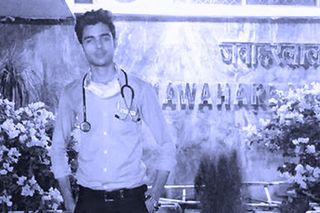
AIIMS’ Fake Doctor Exemplifies Flaws in India’s Health Care
Real-life ‘Munna-Bhai’ is a problem bigger than one man.

Over the past few days, it’s emerged that a 19-year-old from Bihar had successfully posed for months as a doctor at Delhi’s All India Institute of Medical Sciences. Adnan Khurram — who pretended to be a junior doctor by obtaining an official notebook for junior residents and wearing a white lab coat — was arrested over the weekend. In an extremely ‘Munna-Bhai’ turn of events, Khurram told Delhi police he embarked on his deception to facilitate the treatment of his sister, a blood cancer patient at the hospital who faced long waits for consultations.
Khurram did not attended classes, nor treat patients. Much of his time at AIIMS seems to have been spent networking — volunteering with the resident doctors’ association, attending meetings and social activities for medical staff, such as a marathon. In the end, this is what gave him away.
“We were surprised that he could make it to all the events at AIIMS and even those organised by other medical organisations. He claimed to be a junior resident, who usually end up with 18-20 hour shifts. He used to hang out near the coffee shop or the doctors’ hostel every evening. We started wondering how he had so much time,” Dr. Harjit Singh Bhatti, the president of the resident doctors’ association at AIIMS, told the Hindustan Times.
Time does seem to be a key question here, but perhaps not in the way Dr. Bhatti intended. Last year, a report found primary care physicians in India on average spend only two to three minutes in consultation with a patient. Even if that time is doubled for the specialists Khurram’s sister undoubtedly requires, that’s still far short of the 10-minute consultation minimums the Medical Council of India informally called for back in 2011. (And far shorter of the Munna Bhai M.B.B.S. ideal, whose slapstick-but-poignant message about what it means to be a good doctor still feels relevant 15 years later.)
Of course, in a country where the (allopathic) doctor-patient ratio is 1 to 1612, it borders on impossible to devote even that much time to a single patient and still treat everyone. Personal relationships with medical professionals become currency that can make the difference between timely care or not; this is a well-known fact of health care in India. It’s fair for Khurram’s deception to be an affront to the people he duped. However, while we don’t presume to know Khurram’s motivations, his networking activities could be taken as an effort to build social capital with powerful people, people with the knowledge and power to help his ailing sister.
That India is short of doctors isn’t news to anyone. And it’s worth noting that the government has taken steps toward addressing this gap, announcing 12 new AIIMS in the past four years. As of the end of last year, only three appear to have reached even initial stages of construction. It’s by nature a slow-moving effort; even once these institutions are fully constructed, equipped and staffed, it will be several years before their first classes graduate and add to the country’s pool of available doctors.
Until it comes into fruition, we can expect to see more presumably desperate people like Khurram doing whatever it takes to get the care they or their families need. Indeed, per the Hindustan Times report, there have been three other cases of impersonating an AIIMS doctor within the last year, in addition to Khurram’s turn.
The NDTV headline for this affair ran, “Teen Posed As AIIMS Doctor For 5 Months, Then His Luck Ran Out.” Let’s hope his sister’s didn’t as well.
Liesl Goecker is The Swaddle's managing editor.
Related


Mental Health Disorders Are a Leading Cause of Childhood Illness Worldwide
